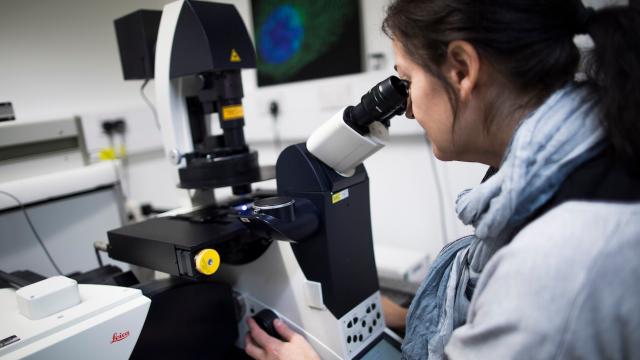While the Trump Administration’s plan for massive cuts to the Environmental Protection Agency has caused a veritable panic, much less discussed has been the proposal to slash the budget of the National Institutes of Health.
Image: Getty
On top of a 20 per cent, $US5.8 billion ($7.6 billion) cut to the agency’s total budget revealed earlier this month as part of the Trump administration’s 2018 budget proposal, on Monday several news outlets reported a new proposal aimed at cutting $US1.2 billion ($1.6 billion) from the agency’s $US34 billion ($44 billion) budget for the current fiscal year. The majority of that money would come from research grants the agency funds, as part of a broader Trump administration push to cut US federal spending by $US18 billion ($23.5 billion) in 2017. If the proposed NIH cuts go through, they are likely to be a disaster — shuttering labs, putting scientists out of work, and (most devastatingly) stymieing research that often leads to medical breakthroughs.
Michael White, a geneticist at the University of Washington in St Louis, told Gizmodo that cuts to the NIH would put his own job at risk.
“I’m a relatively new faculty member,” he said. “So the key to get my new job is getting my first grants. With these cuts I would possibly see those grants slip away. That puts me at a vulnerable place in my career.”
An analysis by the American Association for the Advancement of Science noted that the much larger cuts Trump has proposed for the coming fiscal year would be an unprecedented disaster. “No administration has attempted NIH cuts as large as these since AAAS began formally monitoring the budget process in 1976,” the AAAS noted.
Currently the NIH funds somewhere between 9000 and 10,000 new proposals each year, with the vast majority of funding going to ongoing research that has already been approved. Another analysis by the American Society for Biochemistry and Molecular Biology suggested Trump’s proposed budget could force the NIH to reduce the number of new proposals funded by as much as 88 per cent in 2018, to just 1200 new proposals.
It’s unlikely that either proposal for cuts — for this year or next — will pass in their present form. Trump’s initial budget proposal was only a rough draft, and will undoubtedly see many changes before ultimately going before Congress for a vote. And key Republican lawmakers have already spoken up to say that the plan to slash the NIH budget for 2017 won’t fly.
But cuts of some degree seem imminent. And in the past, seemingly modest budget reductions at the NIH have done serious damage to science. In 2013, as part of the budget “sequestration” deal between the Obama administration and the Congressional GOP, the NIH’s budget was reduced by about five per cent. As a result, the number of research proposals it funded dropped to the lowest level in 20 years, with the agency funding 700 fewer projects.
The NIH plays a crucial role in American science. Its research dollars make up a huge portion of the funding in the US for biomedical research, with scientists at university labs relying on NIH grants to pay research costs and lab employee salaries.
“Most biomedical scientists rely on NIH grants at some point,” White told Gizmodo.
Writing in Pacific Standard, White talked to several fellow scientists who noted that without new NIH grants, they would have to shutter their labs and research associates and graduate students would have to find new places to work. If labs close and jobs are lost, that impact would not be easily reversed by a healthier budget the next year.
Changes could happen swiftly even if the 2017 cuts do not go into effect. White noted that grants he wrote last winter might wind up in the 2018 fiscal budget, which begins in October, meaning he would lose valuable funding he has been counting on as soon as this spring.
NIH research funding has been on a downward trend for over a decade. Between 2003 and 2015, it lost 22 per cent of its capacity to fund research due to budget cuts, inflation and the 2013 budget sequestration. That has resulted in fewer grants funded, and along with that, presumably, fewer scientific discoveries.
“What worries me the most,” White said, “is that when you know the competition for grants is so tight, people play it safe. They don’t throw out their boldest ideas. It impacts innovation.”
Last year, Congress sought to turn that trend around, voting to increase the 2016 budget for the NIH by 5.9 per cent. That enabled the agency to award 832 more research project grants. For 2017, Congress recommended an additional $US2 billion ($2.6 billion) increase, though funding has been frozen at 2016 levels until Congress passes a budget resolution. That’s how Trump could effect funding for the present fiscal year — Congress needs to pass the budget resolution by April in order to avoid a government shutdown, and Trump could threaten veto that budget unless his requests are met.
Now, at a time of incredible breakthroughs in realms like synthetic biology and looming threats like the Zika crisis, Trump seeks to effectively disarm biomedical research.
“The link between medical benefits and research is not always clear, but the connection is there,” White said. “Ultimately by reducing the amount of science we do, we’re going to harm patients. In the end, it’s really not just about scientists.”
